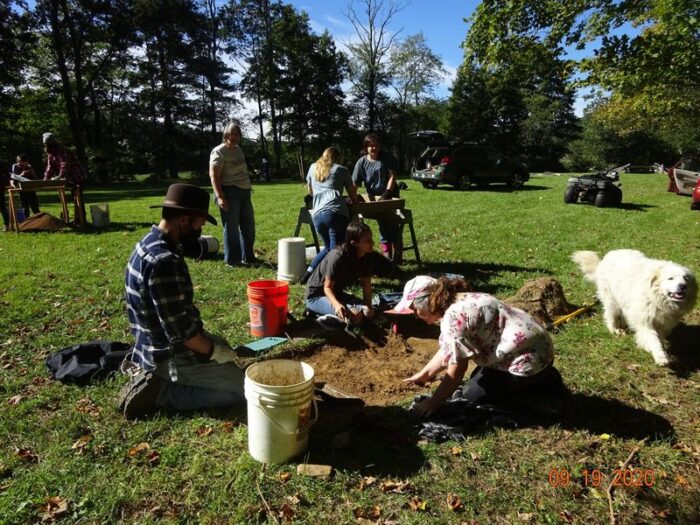Fort Warwick: A Refuge Through Revolution — Celebrating 250 Years
Fort Warwick, a sentinel overlooking Deer Creek in Green Bank, Pocahontas County, West Virginia, stands as a testament to resilience in the face of frontier challenges. This month, Fort Warwick celebrates its 250th anniversary, inviting visitors to step back in time and explore its rich history.
A Refuge During Unrest
In June 1774, the Augusta County Militia of Virginia arrived and built a stockade at Fort Warwick. This stockade became a training ground for over 100 militiamen who would later participate in a pivotal battle against the Shawnee in Point Pleasant.
The Battle of Point Pleasant proved to be a turning point. Thanks to the advantageous firepower of the militia and the units there, the Shawnee retreated. This victory not only secured the Virginia frontier but also pushed the border westward to the Ohio River.
However, the fort’s significance extends far beyond this single battle. With tensions rising between colonists, Native American tribes and the British, Fort Warwick became a crucial safe haven.
“The settlers would tend to kind of cluster in neighborhoods or communities,” explains Dr. Stephen McBride, from the University of Kentucky, alongside his wife Dr. Kim McBride, both instrumental in the ongoing archaeological digs at the site.
Fort Warwick provided a place of refuge for these communities during the tumultuous years of the American Revolution. While many of the men who trained there returned home believing their militia service was over, the revolution had begun by the spring of 1775.
The British, in an attempt to weaken the colonists, encouraged Native American tribes, particularly the Shawnee, to attack frontier settlements. With promises of regaining lost land, the British successfully incited some raiding in the area. However, the network of forts along the Greenbrier River, including Fort Warwick, proved to be a vital defense system.
“These forts served as a refuge for men, women and children who were left here and weren’t involved in action up north in the Revolution, or down south in the Carolinas,” says Bob Sheets, owner of Fort Warwick.
For the next eight years, until 1783, Fort Warwick remained occupied by a skeleton militia crew, offering a safe haven for those unable to fight but directly impacted by the conflict.

Unearthing The Past
Following the war, Fort Warwick was likely dismantled by the Warwick family to resume agricultural activities. Its location remained a local legend for generations until its rediscovery in 2004 by Dr. Stephen McBride and Dr. Kim McBride. Since then, archaeological excavations have unveiled a wealth of artifacts and shed light on the fort’s layout, including a potential earlier round structure pre-dating the militia fort.
After reading the pension records that hinted at the fort’s location on the upper Greenbrier River, the McBrides embarked on their search. Their quest led them to the Arborvale Trench General Store, where they were pointed to a local historian, James “Jimmy” Whittle. Whittle, in turn, directed them to the farm owned by Jamie Sheets, where his son Bob resided.
Intrigued by the possibility, Dr. Kim McBride began exploring the farm with a metal detector, uncovering colonial artifacts. In 2006, the McBrides led their first official excavation, unearthing the fort’s western bastion and using soil stains to trace its perimeter.
Over the past two decades, the McBrides have spearheaded numerous archaeological digs at Fort Warwick. The latest excavation involved over 150 Pocahontas County High School students, offering them a hands-on learning experience in archaeology.
“The whole purpose of archaeology is to take the bits and pieces of what is left behind and try to produce a narrative out of that, a story that can be told,” says Sheets. “And we’ve got some interesting stories.”
These ongoing efforts continue to shed light on what transpired at Fort Warwick during this significant period in history. The McBrides plan to continue their work throughout the year, with additional digs planned for September. Their dedication promises to provide a clearer picture of the fort’s architectural features, the lives of those who occupied it and the role it played in shaping the region’s history.

Fort Warwick’s 250th Anniversary Celebration
This June 22 and 23, Fort Warwick will come alive with its 250th Anniversary Celebration. Witness colonial reenactors bring the 18th century to life with demonstrations of essential frontier skills and crafts. Musicians will fill the air with period music, while artisans showcase their trades. For those eager to contribute to historical discovery, participation in ongoing archaeological digs alongside professionals will be available.
The celebration extends with a tour of the historic Warwick Cemetery and the Fort Warwick Museum. Top off your historical adventure with a taste of history! Learn the traditional art of maple syrup production at the fort’s sugar shack.
This is a unique opportunity to connect with the very roots of Pocahontas County. Experience the stories of Fort Warwick firsthand and feel history come alive. For more information and updates on the excavation and celebration, visit Fort Warwick’s Facebook page.
Note: We would like to express our sincere gratitude to Bob Sheets and Dr. Stephen McBride for their valuable insights and contributions to this blog post. Their knowledge and passion for Fort Warwick were instrumental in sharing its story.
